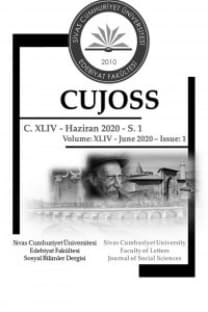Gelişme ve Ekolojik Modeller
Bu makalede “gelişme teorileri” çerçevesinde “Büyümenin Sınırları” ile “Yoksulluğun Sınırları” adlı ekolojik modeller incelendi. Çalışmanın cevap aradığı ana soru “acaba ekolojik modeller günümüzdeki sanayi uygarlığının sonucu olarak ortaya çıkan çevre problemlerini çözebilir mi?” idi. Bu soruya cevap aramak için tartışmanın en çok yapıldığı ve ekolojik hareketin güçlü olduğu yerlerden biri olan Almanya’da Almanca kaynaklar seçildi. Öncelikle “gelişme teorilerini” ve bu iki modeli anlama yoluna gidildi. Sonuç olarak iki modelde de mevcut birikim modellerinin dışına çıkılamadığı dolayısı ile de “gelişme teorilerinin” her şeye cevap veremediği ayrıca da sorgulanmadığı tespiti yapıldı. Genel olarak “gelişme” sanayileşme ile özdeş tutuldu, buradan hareketle de bu kavram sorgulanmadan çevre sorunlarının halledilemeyeceği sonucuna varıldı.
Development and Ecologic Models
This article explored ecologic models named “Limits of Growth” and “Limits of Poverty” in context of “development theories”. The major question that the study searched for an answer was “could ecological models solve environmental problems that results from contemporary industrial civilization?” In search for an answer to this question, the study reviewed the literature in German in Germany which was one of the sites that ecologic movement was strong and home for intense debates. Upon examination of development theories and these two models, the study found that both theories could not go beyond accumulation models and failed to question development concept, while development theories could not respond to everything societal. The research concluded that environmental problems could not be answered without questioning development concept since “Development” and industrialization terms were used identically.
___
- DURNING, A.B. (1992), Die Armutsfalle:die Beziehung zwischen Armut und Umwelt:die Elendspiralle umdrehen, Schwalbach imTaunus.
- GLOBAL 2000. (1981), Der Berichet an den Prasident der USA,16.Aufl., Frankfurt a.M.
- GRÜN, J./ D. Wiene,.(1984), Global Denken, vor Ort handeln.Weltmodelle von Global bis Herrmann Kahn, Freiburg.
- HARBOURT, H. J. (1986), Ökologiedebatte und Entwicklungstheorie, in:Sominis,U.E (Hg.),Entwicklungstheorie-Entwicklungspraxis.Eine Kritische Bilanzierung, Berlin.
- HARBORTH, J.-H., (1993), Sustainable Development-Dauerhafte Entwicklung, in: Nohlen, D. ve Nuscheler, F., (Hrsg), Handbuch der Dritten Welt,1.Bd., Grundprobleme, Theorien und Strategien, 3. Aufl., Bonn.
- HERRERA, A.o.u.a. (1977), Grenzen des Elends-des Bariloche-Modell, Frankfurt a.M.
- MARMORA, L. (1990), Ökologie als Leitbild der Nord-Süd-Beziehungen Clup of
- MENZEL, U.(1993), 40 Jahre Entwicklungsstratrgie = 40 Jahre Wachstumstrategie, in: NOHLEN, D ve NUSCHELER (Hrsg.) Handbuch der Dritten Welt, 1. Bd., Bonn Rome- Braundland-Kommission-Erdpolitik, in:Peripherie, Nr.:39/40,1990.
- MEADOWS, D.,/MEADOWS, D. (1972), Die Grenzen des Wachstums. Bericht des Clup of Rome, Stutgart.
- MEADOWS, D./MEADOWS, D. (1974), Das Globale Gleichgewicht. Modellstudien zur Wachstumskrise, Stutgart.
- MEADOWS, D./MEADOWS, D. (1992), Die nerven Grenzen des Wachstums, Stutgart.
- MESAROVİÇ, M., E. Pestel. (1974), Menschheit am Wendepunkt, 2. Bericht an den Clup of Rome Zur Weltlage, Stutgart
- PECCEİ, A., M. Siebker. (1974), Die Grenzen des Waschstums. Fazit und Folgestudien, Reinbek.
- SACHS, Wolfgang. (I995), Nachhaltige Entwicklung, Zur Politischen Anatomie eines Schlagwortes, DGB-Bildungswerk Materialien Nr.32, Düsseldorf.
- ISSN: 1305-5143
- Yayın Aralığı: Yılda 2 Sayı
- Yayıncı: Sivas Cumhuriyet Üniversitesi Edebiyat Fakültesi
Sayıdaki Diğer Makaleler
Atatürk Döneminin Dil Kültür Ve Edebiyat Politikalarını Yansıtan Bir Halkevi Dergisi: Ortayayla
16. Yüzyılda Müezzin Bir Şâir: Hüdâyî-İ Kadîm
Yüklemin Özne ve Nesne İlişkisi
“Program Geliştirme” Kavramına İlişkin Metaforlarla Yeni İlköğretim Programlarına Farklı Bir Bakış
